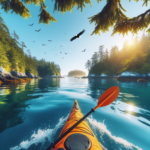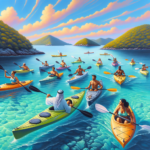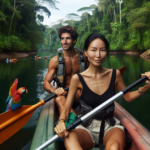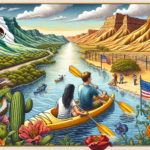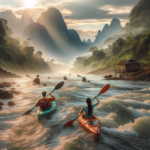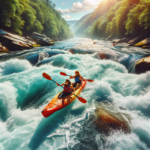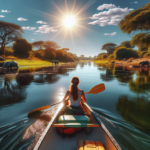Kayaking in Lake Tahoe, California/Nevada, USA
Introduction to Kayaking
Kayaking is a popular outdoor activity that offers a unique blend of adventure, exercise, and a close connection with nature. Whether you’re paddling through serene lakes, navigating swift rivers, or exploring coastal waters, kayaking provides an exhilarating experience that appeals to both beginners and seasoned enthusiasts. The sport has grown in popularity over the years, thanks to its accessibility and the minimal equipment required to get started.
In this article, we will spotlight the unique features of kayaking in Lake Tahoe, California/Nevada, USA. This stunning destination offers a variety of kayaking experiences that cater to all skill levels. From its crystal-clear waters to its breathtaking scenery, Lake Tahoe is a kayaker’s paradise. We’ll explore what makes this location so special and why it should be on every kayaker’s bucket list.
Lake Tahoe’s unique geographical features, combined with its rich history and vibrant culture, make it an exceptional spot for kayaking. The lake straddles the border between California and Nevada, offering diverse landscapes and a range of water conditions. Whether you’re looking for a peaceful paddle or an adventurous expedition, Lake Tahoe has something for everyone.
In the following sections, we’ll delve into the specifics of kayaking in Lake Tahoe, including the best spots to visit, the ideal times to go, and important safety considerations. We’ll also provide information on local amenities, accommodations, and environmental practices to ensure you have a safe and enjoyable experience.
Overview of Kayaking in Lake Tahoe, California/Nevada, USA
Lake Tahoe is a large, freshwater lake located in the Sierra Nevada mountains, straddling the border between California and Nevada. Known for its stunning clarity and vibrant blue color, the lake is surrounded by picturesque mountains and lush forests. The lake’s geography offers a variety of kayaking experiences, from calm, sheltered bays to more challenging open-water conditions.
The climate in Lake Tahoe is characterized by warm, dry summers and cold, snowy winters. The best time for kayaking is typically from late spring to early fall when the weather is mild, and the water is more accessible. During these months, the lake’s surface temperature ranges from 50 to 70 degrees Fahrenheit, making it comfortable for paddling.
Historically, Lake Tahoe has been a hub for water sports and outdoor activities. The lake’s pristine waters and scenic surroundings have attracted visitors for generations. Kayaking has become increasingly popular in recent years, thanks to the growing interest in eco-friendly and adventure-based tourism. The local community has embraced this trend, offering a range of services and amenities to support kayakers.
Accessing Lake Tahoe is relatively easy, with several major highways and airports nearby. The lake is approximately a two-hour drive from Sacramento, California, and about an hour from Reno, Nevada. Once you arrive, you’ll find numerous launch points and rental facilities around the lake, making it convenient to start your kayaking adventure.
Kayaking Conditions in Lake Tahoe, California/Nevada, USA
Lake Tahoe offers a variety of water conditions that cater to different kayaking preferences. The lake’s vast expanse provides opportunities for both tranquil paddling in sheltered coves and more challenging excursions in open water. The water is generally calm in the morning, with winds picking up in the afternoon, creating small waves and choppier conditions.
The weather in Lake Tahoe can vary significantly throughout the year. Summers are warm and dry, with daytime temperatures ranging from 70 to 90 degrees Fahrenheit. This is the most popular time for kayaking, as the weather is ideal for outdoor activities. Fall offers cooler temperatures and fewer crowds, making it another great time to visit. Winters are cold and snowy, with the lake often partially freezing over, making kayaking less feasible.
Water currents in Lake Tahoe are generally mild, but it’s essential to be aware of the wind patterns, especially in the afternoon. The prevailing winds come from the southwest, which can create challenging conditions for kayakers. It’s advisable to start your paddle early in the day to avoid the stronger afternoon winds.
Environmental factors such as water temperature and clarity also play a role in the kayaking experience. Lake Tahoe is known for its exceptionally clear water, with visibility often exceeding 70 feet. This clarity allows kayakers to see the lake’s underwater features and marine life, adding an extra layer of enjoyment to the experience.
Top Spots for Kayaking in Lake Tahoe, California/Nevada, USA
One of the top spots for kayaking in Lake Tahoe is Emerald Bay. This picturesque bay is known for its stunning scenery, including the iconic Fannette Island and the historic Vikingsholm Castle. The calm waters and sheltered location make it an ideal spot for beginners and those looking for a relaxing paddle. The best time to visit is early in the morning when the water is calm, and the bay is less crowded.
Another popular kayaking destination is Sand Harbor, located on the Nevada side of the lake. Sand Harbor offers crystal-clear waters, sandy beaches, and impressive rock formations. The area is also home to a variety of wildlife, including fish, birds, and even the occasional bear. The best time to kayak here is during the summer months when the weather is warm, and the water is inviting.
For those seeking a more challenging adventure, the East Shore offers a rugged and less-developed coastline. This area features rocky outcrops, hidden coves, and stunning views of the surrounding mountains. The East Shore is best suited for experienced kayakers due to its more exposed conditions and potential for stronger winds and waves.
Lastly, the West Shore offers a mix of calm waters and scenic beauty. This area is known for its charming lakeside communities, historic sites, and lush forests. Popular launch points include Meeks Bay and Tahoe City, both of which offer easy access to the water and a range of amenities. The best time to kayak on the West Shore is during the late spring and early fall when the weather is mild, and the crowds are smaller.
Safety and Regulations
Safety is paramount when kayaking in Lake Tahoe. Local regulations require all kayakers to wear a personal flotation device (PFD) at all times. It’s also recommended to carry a whistle or other sound-producing device to signal for help if needed. Additionally, kayakers should be aware of the weather forecast and avoid paddling in adverse conditions.
It’s essential to have the right safety gear and equipment when kayaking in Lake Tahoe. In addition to a PFD, consider wearing a wetsuit or drysuit, especially during the colder months. A bilge pump, paddle float, and first aid kit are also valuable items to have on hand. Always let someone know your planned route and estimated return time before heading out on the water.
In case of an emergency, it’s crucial to know how to handle the situation. If you capsize, stay with your kayak and try to re-enter it as quickly as possible. If you’re unable to get back in, use your whistle or other signaling device to attract attention. It’s also helpful to have a basic understanding of self-rescue techniques and to practice them regularly.
Local authorities and organizations offer various resources to help ensure a safe kayaking experience. The Lake Tahoe Water Trail Association provides maps, safety tips, and information on launch points and amenities. Additionally, many local outfitters offer guided tours and safety courses to help kayakers build their skills and confidence on the water.
Amenities and Accommodations
Lake Tahoe offers a wide range of amenities to support kayakers. Numerous rental facilities around the lake provide kayaks, paddles, and safety gear. Many of these facilities also offer guided tours, which can be a great way to explore the lake with the help of an experienced guide. Popular rental locations include Tahoe City, South Lake Tahoe, and Incline Village.
When it comes to accommodations, Lake Tahoe has something for everyone. From luxury resorts and hotels to cozy cabins and campgrounds, there are plenty of options to suit different preferences and budgets. Some popular lodging options include the Ritz-Carlton Lake Tahoe, the Hyatt Regency Lake Tahoe, and the Camp Richardson Historic Resort & Marina.
For those who prefer a more rustic experience, several campgrounds around the lake offer tent and RV sites. These campgrounds often provide easy access to the water and stunning views of the surrounding landscape. Popular campgrounds include D.L. Bliss State Park, Emerald Bay State Park, and Zephyr Cove Resort.
In addition to kayaking, Lake Tahoe offers a variety of other recreational activities. Hiking, biking, fishing, and swimming are popular options for those looking to explore the area further. During the winter months, the region transforms into a winter sports paradise, with world-class skiing and snowboarding at resorts like Heavenly, Squaw Valley, and Northstar.
Environmental Considerations
Preserving the natural beauty and ecological health of Lake Tahoe is essential for ensuring that future generations can enjoy its pristine waters. Kayakers can play a crucial role in conservation efforts by practicing eco-friendly habits while on the water. This includes avoiding littering, respecting wildlife, and minimizing disturbances to natural habitats.
One of the key guidelines for eco-friendly kayaking is to follow the “Leave No Trace” principles. This means packing out all trash, avoiding the use of single-use plastics, and being mindful of your impact on the environment. Additionally, kayakers should avoid disturbing wildlife and maintain a safe distance from animals to prevent stress and disruption to their natural behaviors.
Several local organizations and initiatives are dedicated to preserving Lake Tahoe’s natural environment. The League to Save Lake Tahoe, also known as Keep Tahoe Blue, is a prominent organization focused on protecting the lake’s clarity and health. Visitors can support these efforts by participating in clean-up events, volunteering, or making donations to conservation projects.
Another important aspect of environmental stewardship is preventing the spread of invasive species. Before launching your kayak, make sure to clean, drain, and dry your equipment to prevent the introduction of non-native plants and animals. Many launch points around the lake have inspection stations to help ensure that kayaks are free of invasive species.
By following these guidelines and supporting local conservation efforts, kayakers can help protect Lake Tahoe’s unique ecosystem and ensure that it remains a beautiful and vibrant destination for years to come.
Highlights
When comparing kayaking in Lake Tahoe to other popular kayaking destinations, several unique features stand out. One of the most notable aspects of Lake Tahoe is its exceptional water clarity. With visibility often exceeding 70 feet, kayakers can enjoy stunning underwater views that are rare in other locations. This clarity is due to the lake’s high elevation and low levels of pollutants.
Lake Tahoe’s diverse geography also sets it apart from other kayaking destinations. The lake is surrounded by the Sierra Nevada mountains, offering breathtaking views and a variety of landscapes to explore. From sandy beaches and rocky outcrops to lush forests and alpine meadows, the scenery around Lake Tahoe is truly unparalleled.
The lake’s rich history and cultural significance add another layer of interest for visitors. Lake Tahoe has been a popular destination for outdoor enthusiasts for generations, and its shores are dotted with historic sites and landmarks. From the Vikingsholm Castle in Emerald Bay to the historic cabins at Sugar Pine Point State Park, there are plenty of opportunities to learn about the area’s past while enjoying your kayaking adventure.
Finally, Lake Tahoe’s commitment to environmental conservation makes it a standout destination for eco-conscious travelers. The local community and various organizations work tirelessly to protect the lake’s natural beauty and ecological health. By visiting Lake Tahoe and supporting these efforts, kayakers can enjoy a world-class paddling experience while contributing to the preservation of this unique and precious environment.
FAQ Section
- What is the best season to go kayaking in Lake Tahoe? The best season for kayaking in Lake Tahoe is from late spring to early fall when the weather is mild, and the water is more accessible.
- Are there beginner-friendly spots for kayaking in Lake Tahoe? Yes, Emerald Bay and Sand Harbor are great spots for beginners due to their calm waters and sheltered locations.
- What should I bring for a kayaking trip in Lake Tahoe? Essential items include a personal flotation device (PFD), paddle, whistle, sunscreen, hat, water, snacks, and appropriate clothing for the weather.
- Are kayak rentals available at Lake Tahoe? Yes, there are numerous rental facilities around the lake that offer kayaks, paddles, and safety gear.
- How can I participate in local conservation efforts? You can support conservation efforts by following eco-friendly practices, participating in clean-up events, volunteering, or making donations to organizations like Keep Tahoe Blue.
- Are guided kayaking tours available? Yes, many local outfitters offer guided tours that provide a safe and informative way to explore the lake with the help of an experienced guide.
- What safety measures should I take while kayaking in Lake Tahoe? Always wear a PFD, check the weather forecast, carry a whistle or signaling device, and let someone know your planned route and estimated return time.
Final Thoughts
Kayaking in Lake Tahoe, California/Nevada, USA is a premier destination for kayaking enthusiasts. With its crystal-clear waters, stunning scenery, and diverse landscapes, Lake Tahoe offers an unparalleled paddling experience. Whether you’re a beginner looking for a peaceful paddle or an experienced kayaker seeking adventure, Lake Tahoe has something for everyone.
It’s important to respect local guidelines and conservation efforts to help preserve the natural beauty and ecological health of Lake Tahoe. By practicing eco-friendly habits and supporting local organizations, you can contribute to the protection of this unique environment.
In conclusion, Lake Tahoe is a must-visit destination for anyone who loves kayaking and the great outdoors. Its unique features, rich history, and commitment to conservation make it a standout location for paddling adventures. So grab your paddle, hit the water, and explore the beauty and thrill of kayaking in Lake Tahoe.


